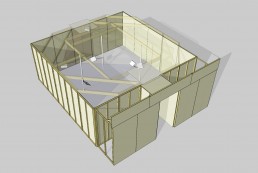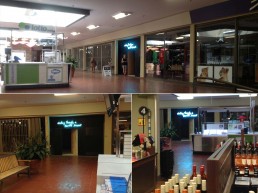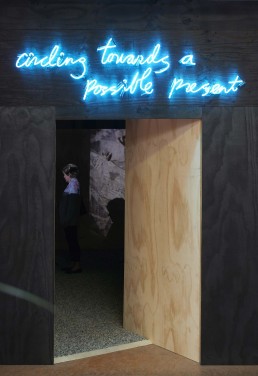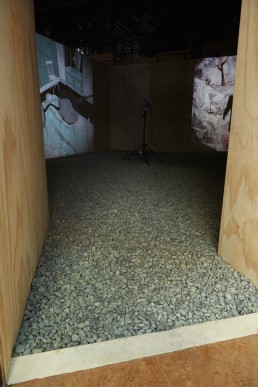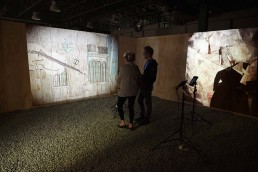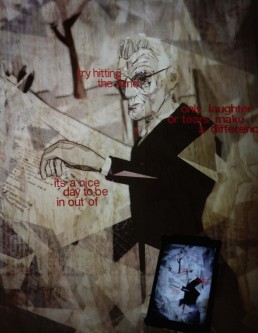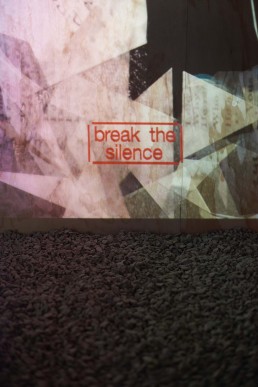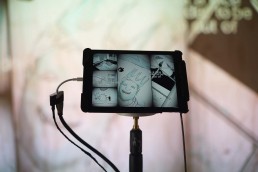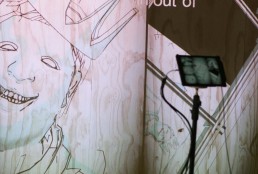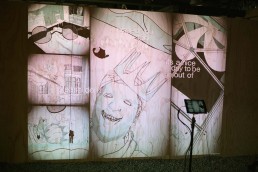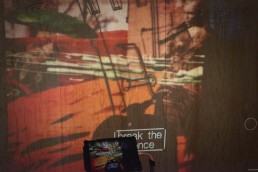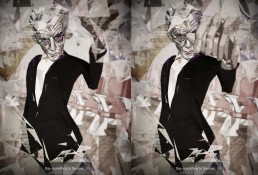“circling towards a possible present”, interactive installation, 2017
tablet controlled, interactive portraits and environment, Sunnycrest Mall, Gibsons, Canada, 2017.
Circling Towards a Possible Present is a new media installation consisting of three interactive, game-engine driven and on-the-fly rendered figurative portraits. The work sits at the intersection of portraiture, film, theatre and video game traditions. It plays with and subverts the expectation of portraiture & interactive 3d games, while considering the inherent theatrical, filmic and painterly dimensions and expectations of these mediums. The project was presented as a complete environment – a pop-up store – in a small town shopping mall.
Read More
This work welcomes one to come in, slow down, and play in the present. The unusual store environment created in a small town shopping mall both embraces and defies expectations. The understated tidy appearance, the familiar neon sign, the prominent mall location, allow the store to slip amongst the everyday spectacle of the mall. But the charred front, the scribbled script and unusual phrase of the neon sign, the crushed rock, the darkened space, the lack of anything to buy, the projections and iPads, the lack of explanation – all contribute to an atypical sensorially rich mall experience. The combination of self-contained plywood room lined with crushed rock creates a natural acoustic amplifier for drawing attention to the the visitors footsteps on the crushed rock, resulting in a visitor being unusually self aware of their movements while in the space. In addition, two of the charred plywood panels have effectively been converted into speakers via attached transducers, and they play a low level collaged soundscape of crashing waves, feet on rocks, winds created by composer Giorgio Magnanensi. The environment is as much a garden as it is a shop. Or hi-tech installation.
These re-imaginings of portraiture pay homage to the legacy of and embrace the perspective of Absurdity. To me, the absurdist perspective implies trying to return my focus to the elusive and illusive present in order to observe and deal with whats truly in front of me, that is, the all caps subtext of my mortality and the inextricable and meaningless drip of life.
Through the three portraits varying presentation, I am attempting to run as quickly and as far as possible away from the 3d game industries bias towards retinal realism and action based first person shooter subject matter. In a paradoxical way, these portraits bring the dead medium of portraiture to life through the gaze and nature of their animate, spatial, 3d dimensional game engine digital sources. However, I am undermining this technological trajectory by choice, design and flaunting of conventions. For example, through the portrait’s subjects themselves; the unwieldy first person point of view; infidelity towards Cartesian space; recycling & re-contextualizing pre-existing “found” elements, including animations, textures and models; super slow motion loops of movement; inappropriate actions; random and inexplicable events; seemingly nonsense textual buttons that trigger ridiculous movement loops; unfixed narrative; unusual framing; unpredictable loss of first person control etc.
In the age of selfies/facebook/Instagram – this age of unstable, real-time evolving, personal narrative – is portraiture dead? What affect might the ever more retinal, immersive and responsive gaming technology have on portraiture? if “a portrait of a dead person” can always be changing, moving and responsive to a users requests, can it even be considered a portrait? What affect does mise-en-scene have on the possible reading of the subject?
The Three Subjects:
Samuel Beckett – The asymmetrical cuboid subject figure is depicted in a spatially sliding faceted theatre space. The overall mise-en-scene implies a theatrical rehearsal. The space is largely empty save for an oversized banana, a sitting figure by a door and a character that seems to be asleep on the stage, holding a gun, sheltered by an umbrella and buried up to her waste. All these elements are riffing on Beckett’s works. The farther one moves from the subject, the more abstract the space becomes. For example, the seats at the back of the theatre are reduced to mere flecks of coloured planes.
Maggie in Place – the Pop-art-ish figure in a trench coat is waiting at an urban street corner. This subject started as an alternate imagining of Maggie Thatcher waiting at an inner city bus stop in the rain, though I think this portrait’s subject has become more general, more like the state(s) of urbanity. Framed in landscape mode, the conventions of perspective, gravity, proportion and representation are selectively applied to the mise-en-scene’s elements, which include dimensional paint strokes and dirt, a suspended exploded clock, crashed car, giant debris and boulders, eddies of text, a grazing horse, and dimensionally drawn buildings, furniture and figures.
The Death of Ubu le Roi, a Not-So-Super-Hero – this Graphic Novel-ish portrait presents five separate points of view in one larger landscape oriented frame. Though at first glance Ubu le Roi may seem to be upright and smiling, the subject is revealed as an immobile figure seemingly lying in state in a modest private space, with a rigor mortis rictus grin. The multiple active points of view provide filmic interest, yet answer little narratively. Secondary, animate mini characters are positioned either side of the reclined figure, their triggered motions dominated by the larger than life dead guy on a slab. Like the other portraits, the mise-en-scene includes Absurdist elements.
The three portraits share camera/user controls, textual buttons, animations and some visual elements.
mtk, 2017
